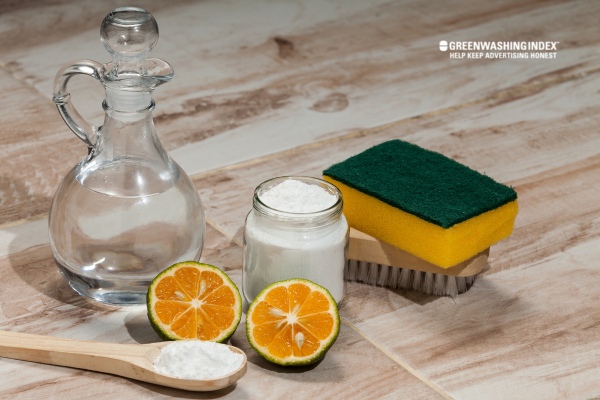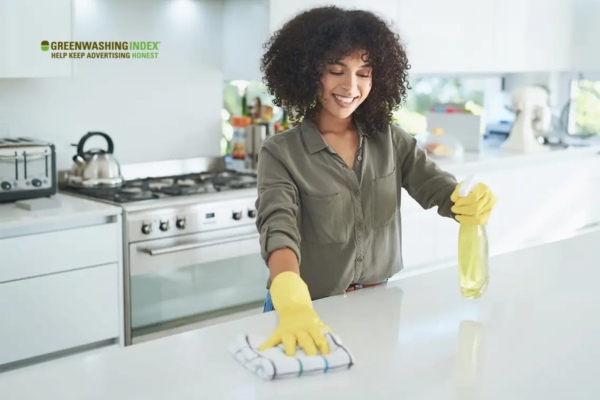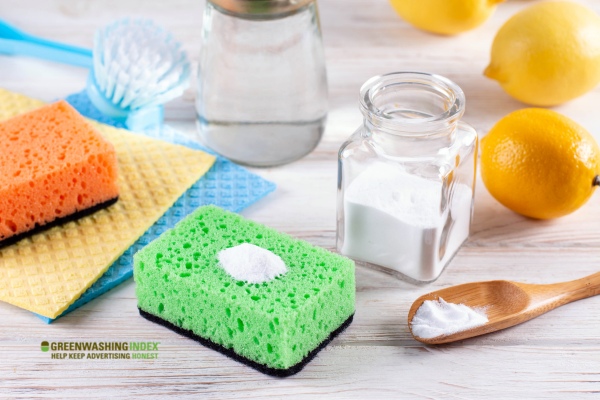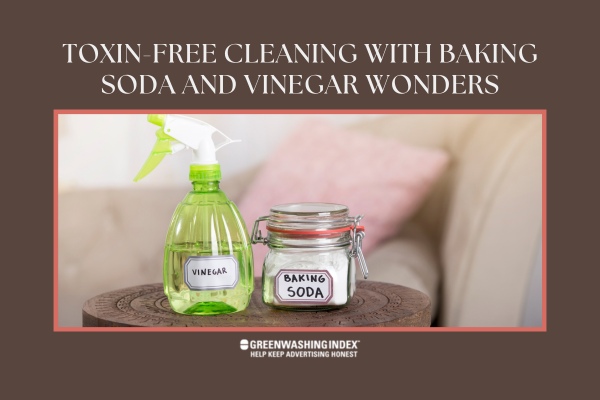Do you ever feel uneasy after using harsh chemical cleaners around your home? Toxin-free cleaning isn’t just a trend; it’s a lifestyle choice that embraces health, safety, and environmental responsibility. I’ve seen it transform homes and lives, including mine. Imagine scrubbing away without worrying about toxic residue where your kids and pets play. That’s the magic of green household tips I’m excited to share with you.
Ah, the endlessly versatile duo for toxin-free cleaning—baking soda and vinegar. Together, they’re like the Batman and Robin of natural cleaning solutions, tackling grime without leaving behind any villainous toxins.
Baking soda brings its gentle abrasive power to the mix, while vinegar cuts through grease with its natural acidity. These two are ordinary pantry items but become extraordinary heroes when they combine their powers in eco-friendly home cleaning.
What You’ll Gain From This Read
- Discover how everyday ingredients can revolutionize your cleaning routine
- Learn simple recipes for powerful natural cleaning solutions
- Uncover the hidden talents of baking soda and vinegar cleaning
- Embrace eco-friendly practices for a greener, safer home
- Maximize your home’s cleanliness with minimal environmental impact.
All About Toxin-Free Cleaning
When I first dove into the world of cleaning, it amazed me how many of those shiny bottles under my sink were brimming with chemicals. That’s when it hit me: maybe I was doing more harm than good.

So, I made a pact to champion toxin-free cleaning in my home. And you know what? It wasn’t just about keeping surfaces spotless—it was also about safeguarding my family’s health and protecting the environment.
Advantages of Toxin-Free Cleaning
Healthier Home:
- No Nasty Chemicals: The most compelling perk is ditching harmful substances like chlorine and ammonia; these nasties can cause respiratory problems and skin irritation.
- Allergy-Friendly: A toxin-free home is like a big ol’ hug for anyone with allergies or asthma since there are fewer irritants floating around.
Environmental Benefits:
- Kind to Nature: Without those chemicals washing down our drains, we’re kinder to waterways and wildlife.
- Biodegradable: Natural cleaners often break down more easily in the environment.
Safety for All:
- Kid & Pet Safe: Your curious kiddos or playful pets won’t find themselves nose-to-bottle with anything toxic.
Cost Effective:
- Penny Savers: Many natural cleaning ingredients might already be hanging out in your pantry, saving you from breaking the bank on specialty cleaners.
The Main Players: Baking Soda and Vinegar
Let’s shine a spotlight on two humble heroes who have made quite the splash in eco-friendly home cleaning—baking soda and vinegar. They’re like Batman and Robin of toxin-free cleaning, except they don’t wear capes… they bubble and fizz!
Baking Soda (aka Sodium Bicarbonate):
- Gentle Abrasive: It can scour away grime without scratching your stuff.
- Odor Absorbent: Your fridge will thank you—no more weird smells!
Vinegar (That’s Acetic Acid for Science Folks):
- Disinfectant Dynamo: While it’s not bleach, it still kicks plenty of germ butt.
- Degreaser Deluxe: Greasy stovetop? Vinegar will slice through that slick faster than a hot knife through butter.
Put ’em together or use ’em solo; these green household tips make baking soda and vinegar cleaning champions. So say goodbye to those harsh chemical concoctions because this dynamic duo is taking center stage in our quest for a sparkly, clean—and green—home!
The Power of Baking Soda in Toxin-Free Cleaning
When I think about my toolkit for toxin-free cleaning, baking soda is that reliable friend who never lets me down. It’s like the humble hero of eco-friendly home cleaning, and I’m excited to share its wonders with you.
Unique Properties
Baking soda is a marvel when it comes to green household tips. Its scientific name, sodium bicarbonate, might sound a bit fancy, but its properties are what truly make it special.
- Natural Deodorizer: Say goodbye to those pesky odors! Baking soda neutralizes pH levels, which means bad smells don’t stand a chance. Whether it’s freshening up a fridge or getting gym funk out of clothes, baking soda tackles it all.
- Gentle Abrasiveness: Without scratching surfaces, baking soda can scrub away grimy residue. From kitchen countertops to bathroom tiles—baking soda provides just enough grit to clean without causing damage.
- Safe and Non-Toxic: As one of the champions of natural cleaning solutions, baking soda poses no threat to you or your family’s health during use, unlike some chemical cleaners that require gloves and masks!
Versatility in Cleaning
The beauty of baking soda lies not just in one function but in its versatility in toxin-free cleaning practices.
- Kitchen Cleaner: Liberally sprinkle some on a damp sponge for an effective clean on stainless steel sinks or greasy stovetops.
- Fabric Softener & Laundry Aid: Who needs synthetic fabric softeners? A half-cup added during the rinse cycle leaves clothes feeling soft.
- Carpet Freshener: Sprinkle over carpets before vacuuming for an extra freshness boost.
- Mildew Remover: Create a paste with water for tackling mildew in damp areas like bathrooms.
And the list goes on! With so many uses around the house right into this white powder, there’s rarely a cleaning challenge I face without reaching for baking soda first. It does wonders on its own, but wait till you see how it performs when joined by its trusty partner: vinegar!
Harnessing The Strength Of Vinegar
Talk about a workhorse in the world of toxin-free cleaning, and vinegar steals the show every single time. It’s not just something to sprinkle over your fries or to dress a salad — this unassuming pantry staple packs a serious punch when it comes to keeping your home squeaky clean without resorting to harsh chemicals.

Natural Acidic Power
Now, let’s break down why vinegar is such a heavy hitter. Its not-so-secret weapon is its natural acidity.
- Dissolves Grime: When it comes down to cutting through grease and grime, the acetic acid in vinegar works like magic. I mean, who needs elbow grease when you’ve got Mother Nature’s own solvent?
- Neutralizes Odors: Vinegar doesn’t just mask odors; it neutralizes them by breaking down the molecules that cause those unpleasant scents.
- Acts Against Bacteria: Thanks to its acidic nature, vinegar goes toe-to-toe with many types of bacteria, making it an ally for sanitizing surfaces.
When you’re using vinegar to clean around your place, remember you’re not just wiping surfaces: You’re unleashing the power of acidity that has been trusted for generations as a potent cleansing agent.
A Multitude Of Uses
Now let’s roll up our sleeves and get into all the ways vinegar can play a part in our home cleaning repertoire:
- Sparkling Windows: Just mix equal parts water and vinegar in a spray bottle for streak-free windows. Trust me; you’ll forget about those window cleaners with unpronounceable ingredients.
- Deodorizing Drains: Pour half a cup of baking soda followed by an equal amount of white distilled vinegar down your drain. It’ll foam up like one of those grade-school volcanoes — but this one freshens up your sink!
- Coffee Makers Clean-Up: Run equal parts water and white vinegar through your coffee machine cycle for an eco-friendly descaling.
And get this – we’re only scratching the surface! Here are more ways this acidic ace can play its part:
- Tile & Grout Cleaner: Mix it with baking soda for scrubbing tile grout.
- Microwave Sanitizer: Heat up some in a bowl inside – steam loosens gunk right off.
- Fabric Softener Alternative: Add half a cup during the rinse cycle for softer clothes without strange additives.
- Dishwasher Rinse Aid: Add some white distilled variety instead of commercial rinse aid for spotless dishes.
So yeah, there’s almost no end to what good ol’ vinegary elixir can do around our homes – all while keeping toxin levels at bay. Just remember, though, that with great power comes great responsibility; don’t pour it over everything without checking if it’s safe (like on natural stone or certain appliances), alright?
With these pointers on tapping into its natural acidic power and exploring its multitude of uses, I hope I’ve shed some light on how versatile and essential white distilled vinegar can be as part of your eco-friendly home cleaning toolkit! Keep embracing that toxin-free cleaning lifestyle – Mother Earth (and probably even future generations) would be giving us thumbs-ups if they could!
Creating Your Own Toxin-Free Cleaning Products
When you’re conscious about the health of your home and the planet, making your own toxin-free cleaning products becomes a rewarding journey. It’s a process that’s both simple and revolutionary, transforming everyday household items into powerful cleaners without any harsh chemicals.

I’ll walk you through two key areas: whipping up your own recipes and managing the use and storage of these homemade wonders.
Mixology 101 – Recipes for Success
The real magic happens when baking soda meets vinegar. Alone, each is a powerhouse, but together, they create fizzing potions capable of tackling the toughest grime. Here are some simple recipes:
- All-Purpose Cleaner: Combine ½ cup of vinegar with ¼ cup of baking soda into 2 liters of water. This concoction can be used on most surfaces – countertops, sinks, even in your bathroom.
- Drain Unclogger: Pour ½ cup baking soda down the drain, followed by ½ cup vinegar. Let it fizz for a moment before flushing it out with hot water.
- Microwave Cleaner: Heat a bowl containing equal parts water and vinegar in the microwave for three minutes or until it steams up—Wipe away loosened food particles effortlessly.
Keep these tips in mind while playing chemist:
- Always add baking soda to vinegar gradually to control fizzing.
- Customize scents using essential oils—lavender for relaxation or citrus for an energizing kick.
Adjustments can always be made. If you need more strength in mold situations or less reactiveness on sensitive surfaces like hardwood floors, tweak accordingly; a little goes a long way.
Tips on Storing & Using Homemade Cleaners
Stashing your eco-friendly arsenal correctly ensures longevity and effectiveness:
- Tight-Seal Containers: Store mixtures in containers with tight-fitting lids to prevent drying out or losing potency.
- Label Clearly: Trust me; you don’t want to mistake your all-purpose cleaner for salad dressing! Label bottles with ingredients and usage dates.
- Shelf Life Awareness: The mixture’s effectiveness may wane over time—use within one month for best results.
Regarding usage frequency:
- For daily messes like kitchen counters or tables, freely use them as needed—it’s safe!
- High-traffic areas such as bathrooms might need weekly attention with your homemade mixtures.
- Periodic treatments (like drain maintenance) should be on an as-required basis—a monthly routine often does the trick!
What you aim for here is balance. Not too much where it becomes wasteful; not too little where dirt builds up.
Remember this simple rule: when it comes to toxin-free cleaning with homemade products—less is more—but consistency is key!
So go ahead and give these easy-peasy formulas and tips a whirl, keeping your space sparkling clean while being kinder to yourself and Mother Nature!
FAQs
Will using baking soda or vinegar damage surfaces?
Not typically, but it’s always wise to test on a small, inconspicuous area first. Baking soda is a mild abrasive, and vinegar is acidic, so it can damage delicate surfaces like marble or unsealed grout if used improperly.
Can I use apple cider vinegar instead of white vinegar?
Absolutely! Apple cider vinegar can be a great alternative for cleaning; however, its slightly stronger scent and color might not be suitable for all uses. White vinegar is preferred for its neutrality.
Why does mixing baking soda and vinegar create a fizz?
When baking soda meets vinegar, the acid-base reaction releases carbon dioxide gas — hence the fizz. This reaction helps lift dirt from surfaces as you clean.
Can these mixtures disinfect surfaces?
While baking soda and vinegar have some disinfectant qualities, they are not as effective as commercial disinfectants against certain germs and bacteria. For thorough disinfection, additional measures may be required.
Conclusion
I’ve come to appreciate the simplicity and effectiveness of toxin-free cleaning with household staples like baking soda and vinegar. This duo truly packs a punch against grime and dirt, all while keeping my living space free from harsh chemicals.
Embracing these eco-friendly alternatives not only benefits my home but also contributes positively to environmental wellness. It’s empowering to know that I can maintain a clean, healthy home with substances that are harmless to my family and the planet.
Key Takeaway Points:
- Toxin-free cleaning promotes a healthier home and environment.
- Baking soda and vinegar are powerful allies in green household cleaning.
- Simplicity in ingredients often equals safety and sustainability.
- Homemade cleaners can be just as effective as commercial ones.
- Adopting natural solutions can lead to innovations in how we care for our spaces.



